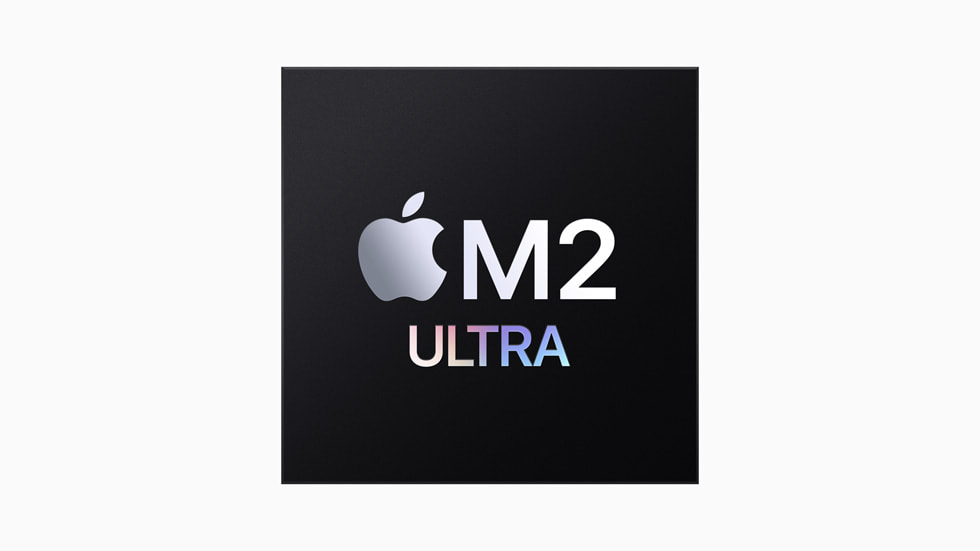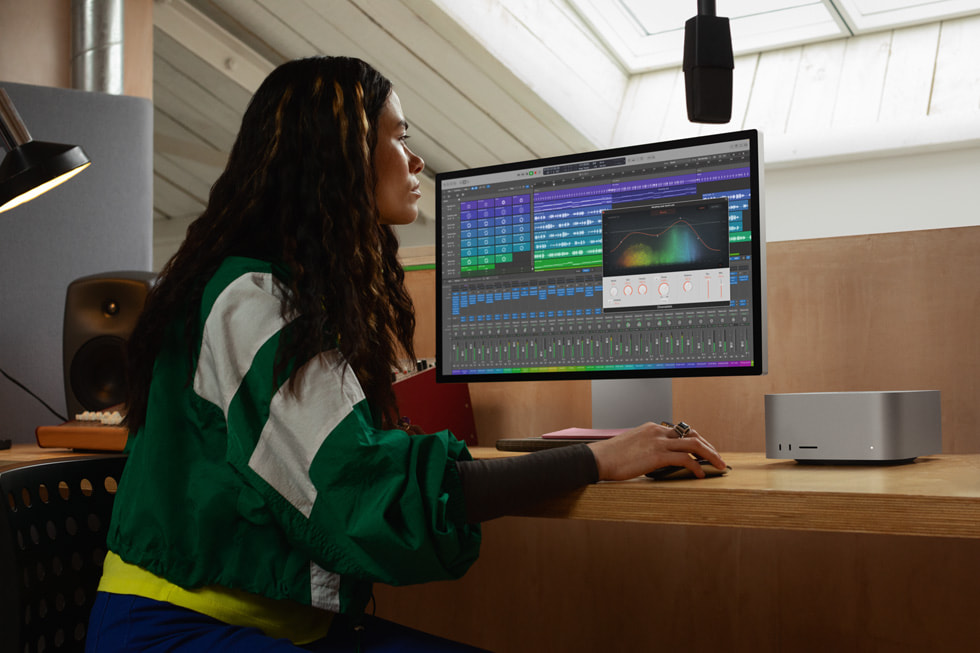PRESS RELEASE
05 June 2023
Apple introduces M2 Ultra
With a faster CPU and GPU, plus support for even more unified memory, M2 Ultra takes Mac performance further than ever
CUPERTINO, CALIFORNIA Apple today announced M2 Ultra, a new system on a chip (SoC) that delivers huge performance increases to the Mac and completes the M2 family. M2 Ultra is the largest and most capable chip Apple has ever created, and it makes the new Mac Studio and Mac Pro the most powerful Mac desktops ever made. M2 Ultra is built using a second-generation 5-nanometer process and uses Apple’s groundbreaking UltraFusion technology to connect the die of two M2 Max chips, doubling the performance. M2 Ultra consists of 134 billion transistors — 20 billion more than M1 Ultra. Its unified memory architecture supports up to a breakthrough 192GB of memory capacity, which is 50 percent more than M1 Ultra, and features 800GB/s of memory bandwidth — twice that of M2 Max. M2 Ultra features a more powerful CPU that’s 20 percent faster than M1 Ultra, a larger GPU that’s up to 30 percent faster, and a Neural Engine that’s up to 40 percent faster.1 It also features a media engine with twice the capabilities of M2 Max for blazing ProRes acceleration. With all these advancements, M2 Ultra takes Mac performance to a whole new level yet again.
“M2 Ultra delivers astonishing performance and capabilities for our pro users’ most demanding workflows, while maintaining Apple silicon’s industry-leading power efficiency,” said Johny Srouji, Apple’s senior vice president of Hardware Technologies. “With huge performance gains in the CPU, GPU, and Neural Engine, combined with massive memory bandwidth in a single SoC, M2 Ultra is the world’s most powerful chip ever created for a personal computer.”
Industry-Leading UltraFusion Technology
M2 Ultra is built from two M2 Max dies connected through UltraFusion, Apple’s industry-leading, custom-built packaging technology. UltraFusion uses a silicon interposer that connects the dies with more than 10,000 signals, providing over 2.5TB/s of low-latency interprocessor bandwidth.
UltraFusion’s architecture enables M2 Ultra to appear as a single chip to software. This means code doesn’t need to be rewritten to utilize the extreme performance of M2 Ultra and makes UltraFusion unlike anything else in the industry.
Unparalleled Performance and Power Efficiency
The 24-core CPU of M2 Ultra consists of 16 next-generation high-performance cores and eight next-generation high-efficiency cores, delivering up to 20 percent faster performance than M1 Ultra. With Mac Studio powered by M2 Ultra, colorists using DaVinci Resolve will experience up to 50 percent faster video processing compared to Mac Studio with M1 Ultra.2
The GPU can be configured with 60 or 76 next-generation cores. This is up to 12 more cores and up to a 30 percent improvement compared to the incredibly powerful GPU of M1 Ultra. Rendering 3D effects using Octane on Mac Studio with M2 Ultra is up to 3x faster than Mac Studio with M1 Ultra.2
Game-Changing Unified Memory Architecture
Apple’s unified memory architecture, a hallmark of Apple silicon, delivers incredible bandwidth, low latency, and unmatched power efficiency. M2 Ultra features 800GB/s of system memory bandwidth, far greater than anything found in a PC. And it can be configured with a massive 192GB of unified memory, which enables workflows not possible on a PC. For example, M2 Ultra can train massive machine learning workloads in a single system that the most powerful discrete GPU can’t even process.3
Advanced Custom Technologies Supercharge Machine Learning, Video, and More
M2 Ultra integrates Apple’s latest custom technologies right on the chip, maximizing performance and efficiency:
- M2 Ultra features a 32-core Neural Engine, delivering 31.6 trillion operations per second, which is 40 percent faster performance than M1 Ultra.
- The powerful media engine has twice the capabilities of M2 Max, further accelerating video processing. It has dedicated, hardware-enabled H.264, HEVC, and ProRes encode and decode, allowing M2 Ultra to play back up to 22 streams of 8K ProRes 422 video — far more than any PC chip can do.
- The display engine supports up to six Pro Display XDRs, driving more than 100 million pixels.
- The latest Secure Enclave, along with hardware-verified secure boot and runtime anti-exploitation technologies, provides best-in-class security.
Better for the Environment
The power-efficient performance of M2 Ultra unlocks new possibilities for even the most demanding pro users without sacrificing environmental responsibility. Today, Apple is carbon neutral for global corporate operations, and by 2030, plans to have net-zero climate impact across the entire business, which includes manufacturing supply chains and all product life cycles. This also means that every chip Apple creates, from design to manufacturing, will be 100 percent carbon neutral.
Mac Transition to Apple Silicon Now Complete
With M2 Ultra powering the new Mac Pro, the Mac transition to Apple silicon is now complete, revolutionizing the laptop and desktop experience. Fueled by continued innovation in Apple silicon, it’s the beginning of a new era for the Mac.
Share article
Media
-
Text of this article
-
Images in this article
- Results are compared to previous-generation Mac Studio systems with Apple M1 Ultra, 20-core CPU, 64-core GPU, and 64GB of RAM.
- Results are compared to previous-generation Mac Studio systems with Apple M1 Ultra, 20-core CPU, 64-core GPU, 128GB of RAM, and 8TB SSD.
- Testing was conducted by Apple in April 2023 using preproduction Mac Studio systems with Apple M2 Ultra, 76-core GPU, and 192GB of RAM, as well as a PC system with NVIDIA RTX A6000 graphics with 48GB GDDR6. Performance measured using select publicly available transformer models. Performance tests are conducted using specific computer systems and reflect the approximate performance of Mac Studio.



